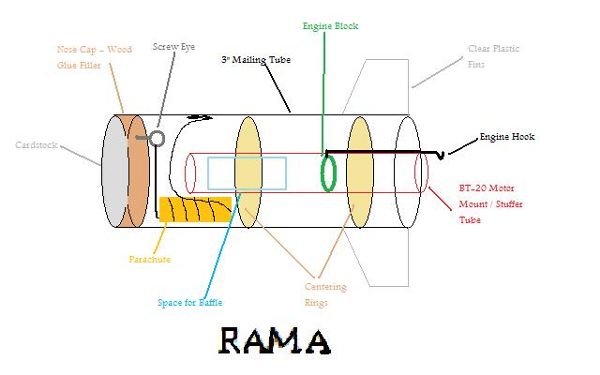| Manufacturer: | Scratch |
Brief:
This is a rough scale model of Rama from Arthur C. Clarke's Rendezvous With Rama. It's made from a piece of
3-inch mailing tube and scrap materials. The fictional Rama is 54km long, making mine roughly 1:270000.

Construction:
Parts list:
- 7.5" of 3" mailing tube
- 1 end cap
- 6" or so of BT-20
- EB-20 and EH-20
- 1/16" cardstock
- 1 screw eye
- thin clear plastic for fins
- parachute and shock cord
- 2" of 1/8" launch lug
- Cut four 3" to 0.75" centering rings from the cardstock.
- Glue the engine block and hook into the aft end of the BT-20.
- Glue two pairs of centering rings together.
- Glue the two thicker rings to the BT-20 engine mount/stuffer tube
- Glue that entire assembly inside the mailing tube so the back end of the motor sticks out 1/2".
- Fill the end cap with wood glue. This adds weight, so you could replace the glue with hard foam or balsa.
- Cut a 3.1" circle of cardstock. Glue it over the wood glue in the nose/end cap.
- Screw the screw eye into the non-cardstock end of the cap.
- Cut out and attach 3 clear fins. The shape doesn't matter--this is NOT built for performance! Use CA or epoxy. Do not use plastic cement or white glue!
- Attach the shock cord and chute. Add the launch lug.
Flight:
I recommend the Estes or Quest C6-3 motors for Rama. A B6-2 is barely acceptable. Do not use a B4 or A8. A B8,
B14, C10, and any 18mm D would work although all are costly.
I recommend either 2-3 sheets of wadding in the stuffer tube or using a baffle. There will be about 3-4 inches on space in the BT-20 for a baffle.
It boosts very straight to about 150 feet on a C6-3. Ejection is right near apogee.
Use at least 3 feet of shock cord. The heavy nose will break anything less than 1/4" elastic. Do not use a standard Estes rubber band.
Anything from a 12" to 18" chute will work. Make sure to use strong shroud lines and fold it to unfold fast as this rocket free-falls very fast.
My first flight was on a B4-2 with no fins. (I attempted to stabilize it using nose weight only.) It staggered to 30 feet before falling back, fortunately with no damage. Again, do not use a B4!
My second flight was with fins on a C6-3. It was a perfect boost to about 150 feet. The parachute melted, and plastic wad recovery was unsuccessful. The only damage was broken fins that were easily re-glued.
Make sure to use a long launch rod as Rama accelerates slowly.
Summary:
Rama is a great simple scale model. Experienced modelers could easily add the hatches, cratered outer wall, and other
features described in the book. It requires only the engine tube, block and hook. Everything else is scratch
components. It would also make a good, cheap testbed for ejection baffles or other experimental devices. Since it's
draggy and heavy, it's ideal for small fields and windy days.
The only con I can think of is that it requires high-thrust, short-delay motors which aren't useful for much else. Also, it's hard to find good clear plastic. I used a spare 1/8" Lexan sheet.
Sponsored Ads
 |
 |











